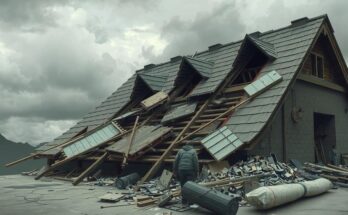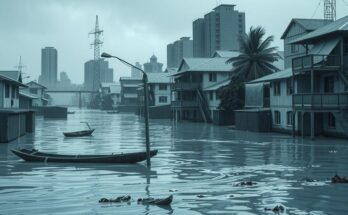The article discusses the Copernicus Sentinel-2 mission’s image of Waza National Park, Cameroon, highlighting its biodiversity, surrounding ecosystems, and the impact of seasonal flooding. The park is a UNESCO World Heritage site and serves as a vital resource for over 100,000 local residents.
The Copernicus Sentinel-2 mission has brilliantly captured the remarkable landscape surrounding Waza National Park in Cameroon. This park is situated in the northern part of Cameroon, bordered by Chad to the east and Nigeria to the west, covering an expanse of 1,700 square kilometers, and is within 10 kilometers of both countries’ borders.
Waza National Park, recognized as the most diverse wildlife reserve in Cameroon, hosts a variety of species, including lions, elephants, giraffes, antelopes, and numerous birds. It was designated a UNESCO World Heritage biosphere reserve in 1979. The park is prominently located on the left side of the green area depicted in the image.
Adjacent to the park is the town of Waza, identifiable as a small yellowish area encircled by lush green land. Surrounding the park is the extensive Logone floodplain, part of the Lake Chad basin. The seasonal flooding of the Logone River, which runs along the Cameroon-Chad border, enriches the verdant landscape visible in the captured image.
The region’s ecosystem is significantly influenced by alternating dry and wet seasons. The rainy season, from mid-May to mid-October, transforms the area into a temporary wetland that supports diverse grasses, reeds, and water bodies. Over 100,000 residents depend on seasonal flooding for fishing, grazing, and agriculture, with agricultural fields evident in the image.
This photograph was taken in November 2024, a time when floodwaters begin to recede, resulting in a fertile landscape. Signs of the impending dry season are apparent; while the park retains its natural vegetation, adjacent areas display brown hues of post-harvest stubble or fallow fields. To the right, the Chari River appears green, merging with the Logone River before eventually feeding into Lake Chad further north. N’Djamena, the capital of Chad, can be observed as a large gray area at the upper section of the image.
In summary, the Copernicus Sentinel-2 mission’s imagery reveals the ecological richness and geographic dynamics of Waza National Park and its surrounding areas. The park serves as a vital wildlife habitat and supports local communities through its seasonal flooding. Understanding these environmental features underscores the importance of this region in terms of biodiversity and local sustenance.
Original Source: www.esa.int




